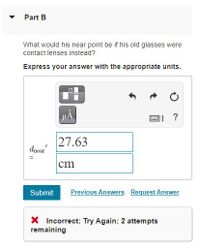
College Physics
11th Edition
ISBN: 9781305952300
Author: Raymond A. Serway, Chris Vuille
Publisher: Cengage Learning
expand_more
expand_more
format_list_bulleted
Concept explainers
Question
A person with a near point of 75.0 cmcm, but excellent distant vision, normally wears corrective glasses. But he loses them while traveling. Fortunately, he has his old pair as a spare.
QA: If the lenses of the old pair have a power of +2.25 dioptersdiopters , what is his near point (measured from his eye) when he is wearing the old glasses if they rest 2.00 cmcm in front of his eye?
QB: What would his near point be if his old glasses were contact lenses instead?
I got the answers
a) 29.63 cm
b) 27.63 cm
however they came out wrong.

Transcribed Image Text:### Understanding Corrective Lenses
**Scenario:**
A person with a near point of 75.0 cm, but excellent distant vision, usually wears corrective glasses. He loses his new pair while traveling but has an old pair as a spare.
---
### Problem Statement: Part A
If the old pair of glasses has a lens power of +2.25 diopters, determine the person's new near point when wearing these glasses positioned 2.00 cm in front of his eyes.
#### Answer Calculation:
1. **Lens Power**: +2.25 diopters
2. **Distance from Eye**: 2.00 cm
3. **Input Field for Answer**:
- \( d_{\text{near}} = 29.63 \, \text{cm} \)
- **Submit Button**: For answer submission.
- **Feedback**: The provided answer was incorrect. A prompt indicates "Try Again" with 2 attempts left.
### Key Concepts:
- **Diopter**: A unit of measurement for the optical power of a lens.
- **Near Point**: The closest point at which the eye can focus on an object clearly.
Understanding and applying these concepts can help solve similar vision correction problems efficiently.

Transcribed Image Text:**Part B**
**Question:**
What would his near point be if his old glasses were contact lenses instead?
Express your answer with the appropriate units.
**Input Field:**
\( d_{\text{near}} = \)
Value: 27.63
Unit: cm
**Buttons and Options:**
- Submit
- Previous Answers
- Request Answer
**Feedback:**
Incorrect; Try Again; 2 attempts remaining
---
**Explanation:**
The question asks for the calculation of the near point when using contact lenses. The answer inputted is 27.63 cm, but it was marked incorrect. Users have 2 more attempts to find the correct answer.
Expert Solution
This question has been solved!
Explore an expertly crafted, step-by-step solution for a thorough understanding of key concepts.
This is a popular solution
Trending nowThis is a popular solution!
Step by stepSolved in 2 steps with 3 images

Knowledge Booster
Learn more about
Need a deep-dive on the concept behind this application? Look no further. Learn more about this topic, physics and related others by exploring similar questions and additional content below.Similar questions
- A woman can see clearly with her right eye only whenobjects are between 45 cm and 135 cm away. Prescriptionbifocals should have what powers so that she can seedistant objects clearly (upper part) and be able to read abook 25 cm away (lower part) with her right eye? Assumethat the glasses will be 2.0 cm from the eye.arrow_forwardI need help please.arrow_forwardThe power in Diptera of the spectacle lens that will enable a near-sighted person to see distant objects clearly is -2D. What is the maximum distance the person can see without wearing the contact lens?arrow_forward
- An office administrator realizes that she is having trouble doing her work due to eyesight problems. Her optometrist determines that without glasses she can focus clearly only on objects that lie at distances between 0.450 m and 4.00 m. The optometrist decides that the best way to handle her eyesight problems is to prescribe bifocals that will give her normal visual acuity from 25.0 cm out to infinity. After trying on several pairs of glasses frames, they agree that the glasses will be a distance of 2.20 cm from her eyes. (a) Determine the refractive power needed for the bifocal part that will correct for her nearsightedness (include the sign). D What type of lens is needed? O converging O diverging (b) Determine the refractive power needed for the bifocal part that will correct for her farsightedness (include the sign). D What type of lens is needed? O converging divergingarrow_forwardSuppose a person's eyes have a relaxed power of 50.62 D. Assume a 2.00 cm distance from the retina to the lens of the eye. What is the far point of the person in m?arrow_forwardA near-sighted man can only focus on distances of dfar = 5.66 m or closer. What power lenses does he need in his glasses for distance vision? Your answer should be in diopters (m-1).arrow_forward
- Consider a patient who nad Taser viSion correctiun that reduced the power 07 her eve by l6.5Diproducing normal dstant YISIon For her. what was the previous Far point o7 a patient in meters ? The power qur normal aY VIS1OD 1s 50.0 D. Tht distance of the image tormaTIon in tht eye is a.00 cm FP=? ar D. The o7 in th is 2.00 cmarrow_forwardq42 Mr ASHER is a nearsighted person, who has a far point of 29.0 cm. Calculate the refractive power (in D) needed for his contact lenses. Enter the numerical part of your answer to two decimal figures. Hint: Remember that the sign of the refractive power is significant.arrow_forwardA very myopic woman has a far point of 23.8 cm. What power contact lens (in D, when on the eye) will correct her distant vision? (Take the lens-to-retina distance to be 2.00 cm.) -0.49 D -0.04 D -2.28 D -4.20 Darrow_forward
arrow_back_ios
arrow_forward_ios
Recommended textbooks for you
 College PhysicsPhysicsISBN:9781305952300Author:Raymond A. Serway, Chris VuillePublisher:Cengage Learning
College PhysicsPhysicsISBN:9781305952300Author:Raymond A. Serway, Chris VuillePublisher:Cengage Learning University Physics (14th Edition)PhysicsISBN:9780133969290Author:Hugh D. Young, Roger A. FreedmanPublisher:PEARSON
University Physics (14th Edition)PhysicsISBN:9780133969290Author:Hugh D. Young, Roger A. FreedmanPublisher:PEARSON Introduction To Quantum MechanicsPhysicsISBN:9781107189638Author:Griffiths, David J., Schroeter, Darrell F.Publisher:Cambridge University Press
Introduction To Quantum MechanicsPhysicsISBN:9781107189638Author:Griffiths, David J., Schroeter, Darrell F.Publisher:Cambridge University Press Physics for Scientists and EngineersPhysicsISBN:9781337553278Author:Raymond A. Serway, John W. JewettPublisher:Cengage Learning
Physics for Scientists and EngineersPhysicsISBN:9781337553278Author:Raymond A. Serway, John W. JewettPublisher:Cengage Learning Lecture- Tutorials for Introductory AstronomyPhysicsISBN:9780321820464Author:Edward E. Prather, Tim P. Slater, Jeff P. Adams, Gina BrissendenPublisher:Addison-Wesley
Lecture- Tutorials for Introductory AstronomyPhysicsISBN:9780321820464Author:Edward E. Prather, Tim P. Slater, Jeff P. Adams, Gina BrissendenPublisher:Addison-Wesley College Physics: A Strategic Approach (4th Editio...PhysicsISBN:9780134609034Author:Randall D. Knight (Professor Emeritus), Brian Jones, Stuart FieldPublisher:PEARSON
College Physics: A Strategic Approach (4th Editio...PhysicsISBN:9780134609034Author:Randall D. Knight (Professor Emeritus), Brian Jones, Stuart FieldPublisher:PEARSON

College Physics
Physics
ISBN:9781305952300
Author:Raymond A. Serway, Chris Vuille
Publisher:Cengage Learning

University Physics (14th Edition)
Physics
ISBN:9780133969290
Author:Hugh D. Young, Roger A. Freedman
Publisher:PEARSON

Introduction To Quantum Mechanics
Physics
ISBN:9781107189638
Author:Griffiths, David J., Schroeter, Darrell F.
Publisher:Cambridge University Press

Physics for Scientists and Engineers
Physics
ISBN:9781337553278
Author:Raymond A. Serway, John W. Jewett
Publisher:Cengage Learning

Lecture- Tutorials for Introductory Astronomy
Physics
ISBN:9780321820464
Author:Edward E. Prather, Tim P. Slater, Jeff P. Adams, Gina Brissenden
Publisher:Addison-Wesley

College Physics: A Strategic Approach (4th Editio...
Physics
ISBN:9780134609034
Author:Randall D. Knight (Professor Emeritus), Brian Jones, Stuart Field
Publisher:PEARSON